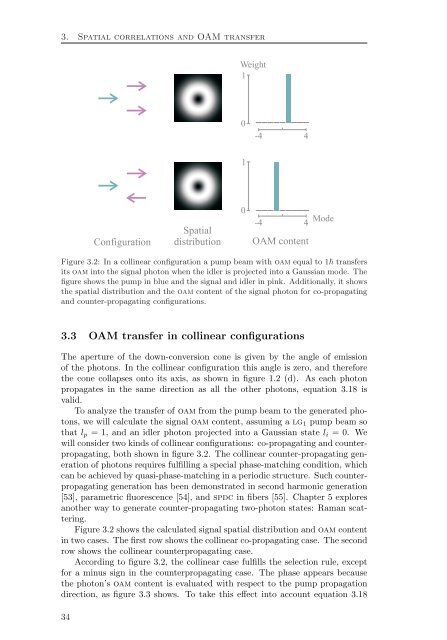Spatial Characterization Of Two-Photon States - GAP-Optique
Spatial Characterization Of Two-Photon States - GAP-Optique
Spatial Characterization Of Two-Photon States - GAP-Optique
You also want an ePaper? Increase the reach of your titles
YUMPU automatically turns print PDFs into web optimized ePapers that Google loves.
3. <strong>Spatial</strong> correlations and OAM transfer<br />
Configuration<br />
Weight<br />
1<br />
0<br />
-4 4<br />
0<br />
<strong>Spatial</strong><br />
-4 4<br />
distribution OAM content<br />
1<br />
Mode<br />
Figure 3.2: In a collinear configuration a pump beam with oam equal to 1 transfers<br />
its oam into the signal photon when the idler is projected into a Gaussian mode. The<br />
figure shows the pump in blue and the signal and idler in pink. Additionally, it shows<br />
the spatial distribution and the oam content of the signal photon for co-propagating<br />
and counter-propagating configurations.<br />
3.3 OAM transfer in collinear configurations<br />
The aperture of the down-conversion cone is given by the angle of emission<br />
of the photons. In the collinear configuration this angle is zero, and therefore<br />
the cone collapses onto its axis, as shown in figure 1.2 (d). As each photon<br />
propagates in the same direction as all the other photons, equation 3.18 is<br />
valid.<br />
To analyze the transfer of oam from the pump beam to the generated photons,<br />
we will calculate the signal oam content, assuming a lg1 pump beam so<br />
that lp = 1, and an idler photon projected into a Gaussian state li = 0. We<br />
will consider two kinds of collinear configurations: co-propagating and counterpropagating,<br />
both shown in figure 3.2. The collinear counter-propagating generation<br />
of photons requires fulfilling a special phase-matching condition, which<br />
can be achieved by quasi-phase-matching in a periodic structure. Such counterpropagating<br />
generation has been demonstrated in second harmonic generation<br />
[53], parametric fluorescence [54], and spdc in fibers [55]. Chapter 5 explores<br />
another way to generate counter-propagating two-photon states: Raman scattering.<br />
Figure 3.2 shows the calculated signal spatial distribution and oam content<br />
in two cases. The first row shows the collinear co-propagating case. The second<br />
row shows the collinear counterpropagating case.<br />
According to figure 3.2, the collinear case fulfills the selection rule, except<br />
for a minus sign in the counterpropagating case. The phase appears because<br />
the photon’s oam content is evaluated with respect to the pump propagation<br />
direction, as figure 3.3 shows. To take this effect into account equation 3.18<br />
34



